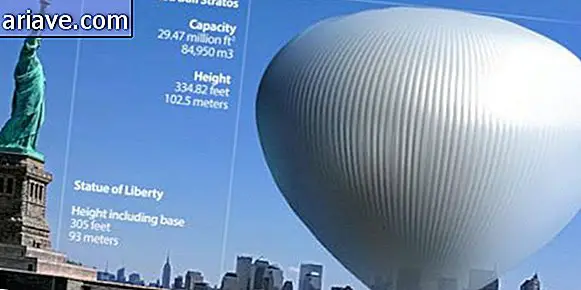Check out 10 space missions that will happen during the year 2016
Apparently 2016 will be the year of space! And it's not because of the hype surrounding the latest Star Wars movies. New expeditions by NASA and other space agencies should help unravel mysteries about Mars, Jupiter and, of course, Earth itself. The programs range from launching satellites that will analyze our planet's climate to devices that will explore other environments and enrich scientists' knowledge of atmospheres in other Solar System stars.
Following the excitement of the success of the mission that passed near Pluto in July 2015 and was able to send crucial information about the dwarf planet, the new expeditions will be crucial for the development of space projects by agencies and private companies. Here are the 10 most anticipated events for space exploration fans. Good trip!
February 7: SpaceX Mission for ISS
SpaceX has a $ 1.6 billion, about $ 6.6 billion, deal with NASA to fly 12 cargo flights to the International Space Station, ISS, carrying all sorts of devices and items needed to supply the base. After several successful expeditions, the seventh trip failed: shortly after taking off from Cape Canaveral, the Falcon 9 rocket was sprayed into the Florida skies in July 2015.
February 7 will mark the return of SpaceX on the ISS cargo transportation service, the first after the crash. With a modified system and some enhanced features, Falcon 9 was already tested in December and appears to be working well. Let's keep an eye on what this long-awaited takeoff will look like.

March 14: European Space Agency mission to Mars begins
The ExoMars mission will take a series of European Space Agency (ESA) ships and modules to get to know the Red Planet better, starting from the initial phase of the project on March 14. On that date, the Trace Gas Orbiter (TGO) will begin its seven-month trip to Mars to find sources of methane, which here on Earth is normally produced by living organisms.
This module will store a wealth of information about the Martian atmosphere during its landing procedure and is considered to be the first step in a long mission that will take the ExoMars vehicle, a life-scout hunter due for departure in 2018, to Mars.

March 18: Astronauts sent to ISS
Three more people should arrive at the ISS in March. These are astronauts Jeffrey Williams, American, and Russians Aleksey Ovchinin and Oleg Skripochka. The trio must travel to the space station as usual via the Russian Soyuz spacecraft, which will depart from a base in Kazakhstan. Souyz's upcoming ISS matches will take place on June 21st, September 23rd and November 16th, all in 2016.

April 5: Falcon Heavy rocket launch
Part of the future Mars colonization plans created by the mind of SpaceX CEO Elon Musk, the Falcon Heavy rocket is to be launched into space from the base of Cape Canaveral for the first time. If all goes well, it will become the largest propellant in the world, with its 68 meters high and the ability to lift 53 tons into orbit.

Midyear: End of Dawn's Space Expedition
Launched in September 2007, the Dawn mission took a spacecraft to study the objects that make up the Asteroid Belt, a cluster of multiple irregular celestial bodies orbiting the sun in the region between Mars and Jupiter. The main targets of this expedition were the dwarf planets Ceres and Vesta, the largest stars found in this sector of the Solar System.
The mission, which cost the US government $ 466 million, should be ended by the ship's fuel depletion. At the moment, it orbits Ceres at a height of 375 km and sends information such as photos and other measurements to Earth. NASA scientists may still be able to prolong Dawn's operation a bit, so the exact date of its shutdown is still a question.

July 4: Juno arrives at Jupiter
The solar-powered Juno spacecraft has the mission of mapping the gravitational and magnetic fields of the largest planet in the solar system: Jupiter. Its launch was made 5 years ago, and scientists predict the arrival of Red Giant orbit on July 4 this year.
This expedition aims to reveal important details about Jupiter's structure and evolution, as well as confirming mysteries that have long disturbed scientists, such as the physical state of the planet's core and the immense storms that plague its surface.

September 8: Launch of OSIRIS-REX Mission
OSIRIS-REX is an acronym for Origins-Spectral Interpretation-Resource Identification-Security-Regolith Explorer. The term - hard to explain - describes NASA's spacecraft and mission that travels to the 500-meter-long Bennu asteroid, which is due to arrive in 2018 only.
The goal of the OSIRIS-REX expedition is to collect an approximately 60g piece of asteroid and return to Earth, which should only happen in the year 2023. The material collected should help us understand the origins and evolution of the Solar System. and give scientists a better idea of the behavior of possible dangerous asteroids for our planet.

September 30: End of Rosetta Mission
The mission Rosetta, the first to orbit a comet, should come to an end on this date with its fall towards the star. Launched in March 2004, the expedition reached orbit 67P / Churyumov – Gerasimenko months later. A module was sent to the frozen surface of the object to collect data about its material and other information.
With the end of the mission, Rosetta should do one last job for scientists: gather various types of data as it falls toward the comet's surface about 4 km long.

End of 2016: European positioning satellites will start working
The European Space Agency will finally put into operation its own global positioning system, their version of the famous American GPS. The Galileo navigation network is due to start operating this year and consists of 30 satellites orbiting the earth. The European global positioning system will be civil, unlike the US GPS, which is controlled by the military.

Year-round: Manned Ship Testing
The year 2016 will be marked by the large number of tests on manned ships in orbit. The number of companies involved in some way with space exploration is increasing, and this considerably increases the number of experimental flights.
The tests will take place on ships like Virgin Galactic's SpaceShipTwo; the XCOR Aerospace Lynx rocket plane; Blue Origin's New Shepard system; the Sierra Nevada Dream Chaser space plane; and SpaceX's Dragon V2 capsules and Boeing's CST-100 Starliner.

The goal of companies such as SpaceX and Boeing is to produce a safe and fast spacecraft capable of transporting astronauts between Earth and the International Space Station, which today is only made by the Russian Soyuz device. NASA has already awarded the two companies $ 2.6 billion and $ 4.2 billion, respectively (about $ 10 billion and $ 17 billion) for producing their space flight capsules.
When do you think humans will step on Mars? Comment on TecMundo Forum
Via TecMundo.











